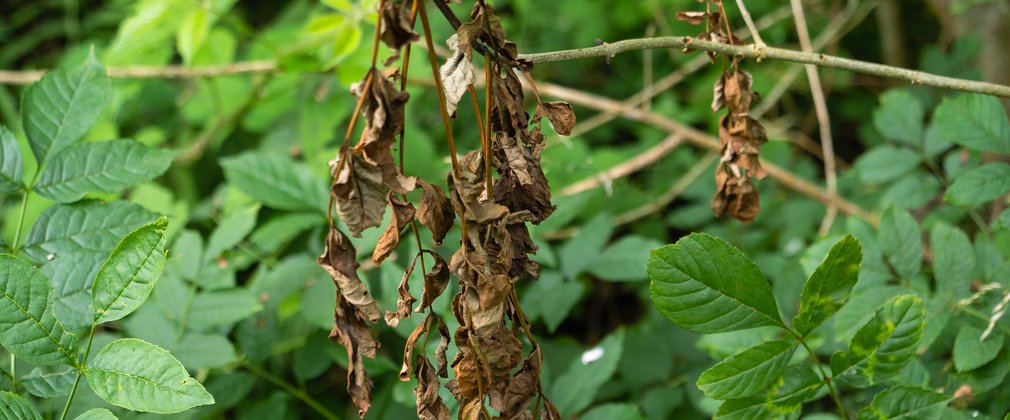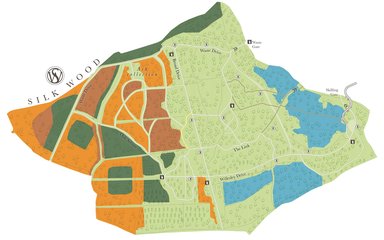
In 2015 Westonbirt staff identified Chalara ash dieback within the woodlands of Silk Wood. A disease which has been sweeping across Europe since 1992 which kills ash species. The top area of Silk Wood, beyond Broad Drive, is part of our response: a fight back to ensure a healthy, diverse and resilient woodland in the future.
2021 - 2022 saw the start of major silvicultural work to remove infected ash trees. This is a highly managed approach which includes three management techniques:
- clear fell and replant areas with large amounts of infected ash trees
- thinning, where possible only remove infected ash and leave space for natural regeneration of other species
- non-intervention to allow us to research the effects of the disease
Despite the dramatic looking change, the approach to clear fell large areas of infected ash trees was a positive step for the woodland. In woodland terms, the removal of ash trees on such a large scale is quite a shock to the ecosystem; but doing this gives us the best possible chance of creating a resilient woodland in future through a considered replanting programme.
Watch our videos below to learn more about how we are managing Chalara ash dieback at Westonbirt Arboretum.
Replanting Silk Wood
Clear fell areas have been left fallow for a couple of years to allow the ground to recover, and give us time to choose the best species to replant with.
We have been working with colleagues in Forest Research and Forestry England to select tree species that will be best suited to this environment and offer the most ecological benefits; including native and near native woodland species that will be resilient towards pests and diseases and our future climate.
Find out more about the Silk Wood Community Planting Project, a three-year project that will create Westonbirt’s first Community Woodland through the involvement of local groups and schools through an exemplary regeneration and replanting of approx. 9,000 trees within Silk Wood.
Want to find out more about Chalara ash dieback? Visit the pest and disease resource from Forestry Research.
Monitoring tolerance to Chalara ash dieback video
This does not mean that the ash tree has disappeared from Silk Wood all together – in some areas Fraxinus excelsior (known as European ash or common ash – which is the disease most affected by Chalara ash dieback) will be retained to monitor the progression of the disease. We have 23 other exotic species of ash which will remain and be carefully monitored for tolerance to the disease. We’ll also continue to monitor native ash specimens that show signs of tolerance.
You can help the Forestry Commission Report monitor the spread of the Chalara ash dieback by reporting any trees that you suspect are in ill-health to the Forestry Commission using Tree Alert.
The Silk Wood Project video
In 2019 some initial work was done to remove infected ash trees from main pathways in the arboretum, to ensure the safety of visitors and staff. In early 2021, contractors clear felled infected trees from large sections in Silk Wood beyond Broad Drive. In early 2022 we completed the felling of ash trees with thinning and coup felling.
Discover how Forestry England are safeguarding trees from pests and diseases and protecting their future.
BBC Points West
5,000 trees, infected with ash dieback, will be felled at Westonbirt Arboretum. Around 2,000 were brought down in 2020, all victim of the disease which has spread throughout the UK. As Steve Knibbs reports, once the felling is finished new species will be planted to bring the areas affected back to life.

Silk Wood Management map
Red: Clear fell and replant (6.74ha) - achieved in 2021
Large scale removal of infected ash trees. Through clear felling we have given Silk Wood the best possible chance to replant these areas for a more resilient woodland to face future climate challenges. These areas will remain fallow for a couple of years to allow the ground to recover.
Amber: Thinning (22.78 ha) - achieved in 2022
Where possible we are looking to only remove dead or dying ash trees, aiding natural regeneration allowing healthy species to grow.
Green: Non-intervention (3.51 ha)
Areas away from visitors will be left, allowing us to monitor and research how the disease develops within ash trees.
Blue: Coppice
We have 22 hectares of actively managed coppice coups.
We all have a part to play in the prevention of the spread of pests and diseases. Though Chalara ash dieback spreads on the wind-borne spores of the fungus Hymenoscyphus fraxineus, and so there is little we can do to prevent the spread of the disease, the spread of other threats can be slowed or stopped by:
- Keep it clean! Pests and diseases can spread in the mud and debris on shoes, paws and tyres, so simple measures such as cleaning your boots and car wheels after a walk in the Forest can help to limit the spread of diseases.
- Don’t risk it! Don’t bring any plant or tree products back from trips abroad, because these might be carrying harmful non-native tree pests or pathogens.
- Be vigilant! Report any trees that you suspect are in ill-health to the Forestry Commission using Tree Alert
- Join us! You can help us to protect Silk Wood against the threat of pests and diseases by joining the Friends of Westonbirt Arboretum. Your membership donation goes directly back into maintaining Silk Wood and Westonbirt Arboretum for future generations.
